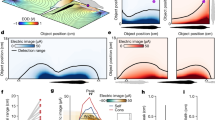An African dung beetle uses the moonlit sky to make a swift exit after finding food.
Abstract
Moonlight, like sunlight1, scatters when it strikes tiny particles in the atmosphere, giving rise to celestial polarization patterns2. Here we show that an African dung beetle, Scarabaeus zambesianus, uses the polarization of a moonlit sky to orientate itself so that it can move along a straight line. Many creatures use the Sun's light-polarization pattern to orientate themselves3,4, but S. zambesianus is the first animal known to use the million-times dimmer polarization of moonlight for this purpose.
Similar content being viewed by others
Main
S. zambesianus starts to forage on the wing for fresh dung at around sunset. Once a source has been located, the beetle quickly forms a ball of dung with its front legs and head (Fig. 1a), and rolls it away in a straight line — the most efficient path for escaping aggressive competition for food in the dung pile. To orientate itself to follow a straight line at dusk, S. zambesianus relies on the polarization pattern formed around the setting Sun to maintain its departure bearing5.
a, The beetle rolling a ball of dung. b, c, Paths taken by beetles (n = 10) moving dung balls outwards from the centre of an arena (diameter, 3 m). On a moonlit night (b), beetles orientate along straight paths; on moonless nights (c), their direction is random. Maximum light intensities were 3.53 × 10−2 cd m−2 and 2.80 × 10−4 cd m−2 in b and c, respectively. d, Change in direction (turn to the right by +70°) taken by a beetle when a perpendicularly polarizing filter (Polaroid HN22; circle represents the extent of the 42-cm-diameter filter) is placed over the beetle at the point indicated by the dot; the beetle resumes its direction of travel on exposure to the open sky. e, Average angles of turn made by 22 beetles when covered by the same filter as in d (filled circles; binned in 5° intervals): left turns, n = 12, −77.0° ± 14.7° (mean ± s.d.); right turns, n = 10, +87.9° ± 9.3°. Under a parallel-polarizing filter (n = 10), beetles deviated by an average absolute angle of 6.7° ± 5.5° (open circles; binned in 5° intervals) from the path they were following before filter placement.
But after astronomical twilight, when the Sun is more than 18° below the horizon, this cue is no longer available. To find out whether the beetles are able to use the polarization of moonlight instead, we monitored their movements under the night-time sky. We found that on moonlit nights, the beetles rolled radially in straight lines away from the dung (Fig. 1b), but that on nights without a moon, they no longer followed a straight-line path (Fig. 1c).
To test whether the beetles' orientation depends on the polarization of the moonlit sky, rather than on the moon itself, we hid the moon from view by shading an arena that contained the beetle and its ball from the rising moon, and placed a polarizing filter over a ball-rolling beetle. The filter had its electric vector (e-vector) transmission axis orientated perpendicularly to the dominant orientation of the e-vector present in the zenith and along the lunar vertical, so the moon's polarized-light pattern appeared to turn through 90° as the beetles continued to roll beneath the filter. In response to this light rotation, the beetles turned close to the expected 90°, either left or right (Fig. 1d, e). The symmetrical pattern of polarized light from the sky does not allow the beetles to discriminate between left and right. As a control, the experiment was repeated with the filter's e-vector orientation parallel to that of the sky, and this resulted in the beetle maintaining its rolling direction under the filter (Fig. 1e). We conclude that it was not the fivefold drop in light intensity experienced by beetles covered by a filter that caused them to change direction.
Our results indicate that these dung beetles orientate by using the polarization pattern of moonlight. Receptors for polarized-light analysis have recently been found in the dorsal-most part of the eye of S. zambesianus5. By using the polarization of moonlight for orientation, S. zambesianus is able to extend its foraging time. Although, to our knowledge, this is the first description of an animal using the moon's polarization pattern as a nocturnal compass, this ability may turn out to be widespread in the animal kingdom.
References
Strutt, J. (Lord Rayleigh) Phil. Mag. 41, 107–120 (1871).
Gál, J., Horváth, G., Barta, A. & Wehner, R. J. Geophys. Res. 106, 22647–22653 (2001).
Waterman, T. H. Handbook of Sensory Physiology Vol. VII/6B (ed. Autrum, H.) 281–469 (Springer, Berlin, 1981).
Wehner, R. J. Exp. Biol. 204, 2589–2596 (2001).
Dacke, M., Nordström., P. & Scholtz, C. H. J. Exp. Biol. 106, 1535–1543 (2003).
Author information
Authors and Affiliations
Corresponding author
Ethics declarations
Competing interests
The authors declare no competing financial interests.
Rights and permissions
About this article
Cite this article
Dacke, M., Nilsson, DE., Scholtz, C. et al. Insect orientation to polarized moonlight. Nature 424, 33 (2003). https://doi.org/10.1038/424033a
Issue Date:
DOI: https://doi.org/10.1038/424033a
This article is cited by
-
Polarization-based underwater geolocalization with deep learning
eLight (2023)
-
Dung beetle optimizer: a new meta-heuristic algorithm for global optimization
The Journal of Supercomputing (2023)
-
Visual odometry of Rhinecanthus aculeatus depends on the visual density of the environment
Communications Biology (2022)
-
The rising moon promotes mate finding in moths
Communications Biology (2022)
-
Navigation and orientation in Coleoptera: a review of strategies and mechanisms
Animal Cognition (2021)
Comments
By submitting a comment you agree to abide by our Terms and Community Guidelines. If you find something abusive or that does not comply with our terms or guidelines please flag it as inappropriate.




